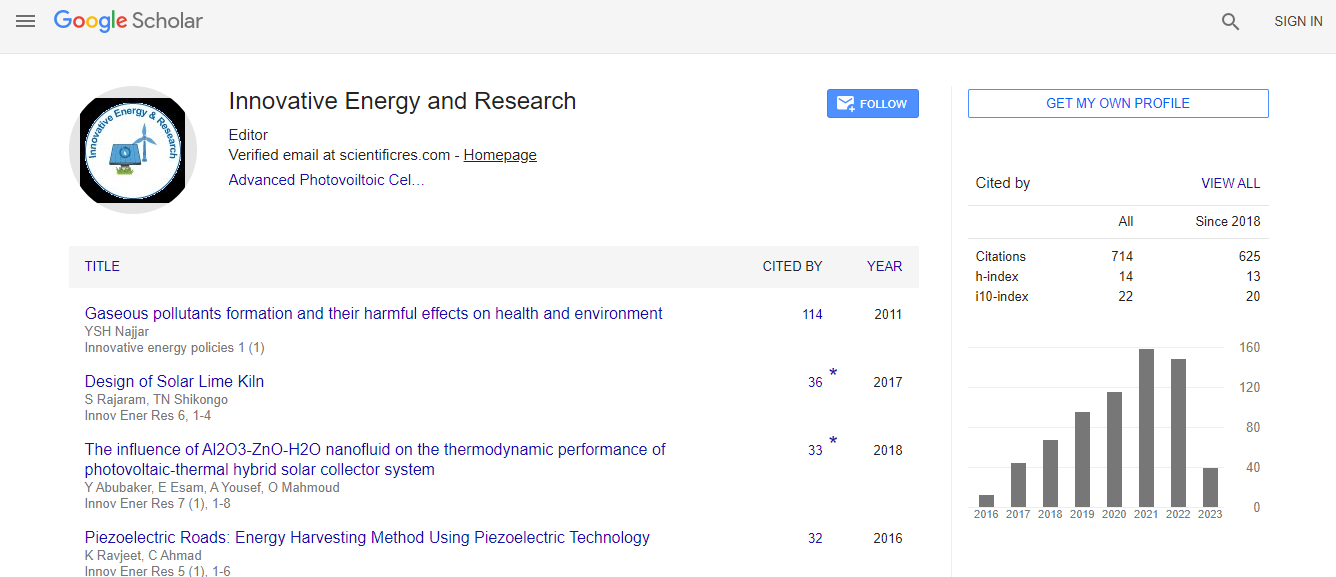Our Group organises 3000+ Global Conferenceseries Events every year across USA, Europe & Asia with support from 1000 more scientific Societies and Publishes 700+ Open Access Journals which contains over 50000 eminent personalities, reputed scientists as editorial board members.
Open Access Journals gaining more Readers and Citations
700 Journals and 15,000,000 Readers Each Journal is getting 25,000+ Readers
Google Scholar citation report
Citations : 712
Innovative Energy & Research received 712 citations as per Google Scholar report
Innovative Energy & Research peer review process verified at publons
Indexed In
- Google Scholar
- Open J Gate
- Genamics JournalSeek
- RefSeek
- Hamdard University
- EBSCO A-Z
- Publons
- Euro Pub
- ICMJE
Useful Links
Recommended Journals
Related Subjects
Share This Page
Overall solar water splitting reactor and plant design towards mass production of H2 and O2
Joint Event on 2nd International Conference on Renewable Energy and Resources & Energy Materials and Fuel Cell Research
Taro Yamada
The University of Tokyo, Japan
ScientificTracks Abstracts: Innov Ener Res
Abstract
This paper overviews our ongoing research and development in designing the sunlight-driven self-running plant for H2+O2 generation from water as the technical goal of our all-Japan research project ”Japan Technological Research Association of Artificial Photosynthetic Chemical Process” (ARPChem). Among various principles and real materials for photocatalytic water splitting, we herein focus on the type of powder photocatalyst from a single light-absorbing material. In this case, H2 evolution from H+ and O2 evolution from OH- in water simultaneously run on a light-responding solid particle generating carriers therein, by the aid of “co-catalytic” materials dressing the surface. For our benchmark pilot plant, we use SrTiO3, the most developed and successful powder photocatalyst. The original study of stoichiometric 2H2+O2 evolution by ultraviolet light was performed on SrTiO3. Later, Al-doped SrTiO3 was introduced as an UV-active stoichiometric water splitting singlepowder photocatalyst that realizes a quantum efficiency of 69% at 320 nm by the aid of CrOx+Rh cocatalyst. Because of the small fraction of UV light within the sunlight, the solar-to-H2 energetic conversion efficiency is approximately 0.6 %. Nevertheless this simplicity of water photo-splitting mechanism is a preferable feature in designing solar plants. In this talk we will further discuss on the design for the photoreactor containing the photocatalyst, inhaling water and exhaling the product gas mixture. The following processes for safe transportation of explosive 2H2+O2 mixture and operation of H2/O2 separation membrane will be also generalized.Biography
Taro Yamada earned his Ph.D. degree at the University of Tokyo in 1984 and since then he occupied professional research scientist’s positions at the Institute for Solid State Physics/the University of Tokyo, ERATO/JST, Waseda University, RIKEN institute and now is a leading member of Japan Technological Research Association of Artificial Photosynthetic Chemical Process (ARPChem) at the University of Tokyo. He has published more than 130 scholarly articles in the basic fields of surface science, catalysis, electrochemistry, and photocatalysis.
E-mail: t_yamada@chemsys.t.u-tokyo.ac.jp

 Spanish
Spanish  Chinese
Chinese  Russian
Russian  German
German  French
French  Japanese
Japanese  Portuguese
Portuguese  Hindi
Hindi 
